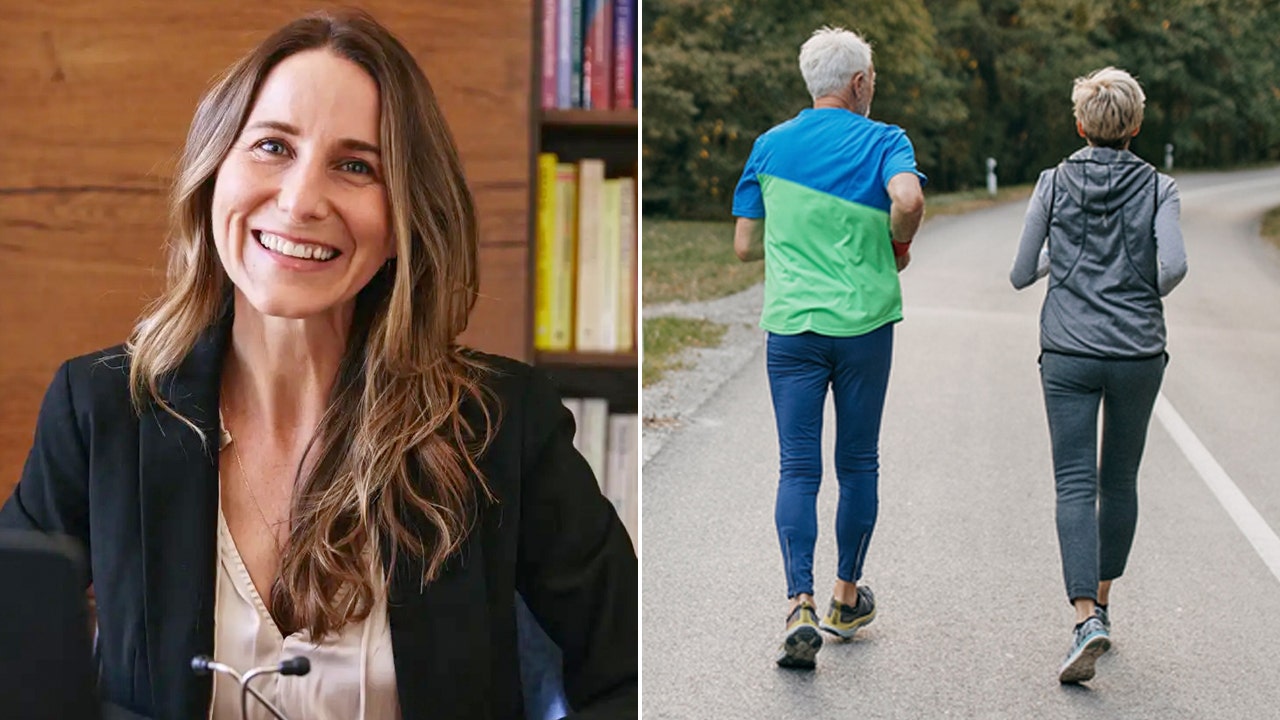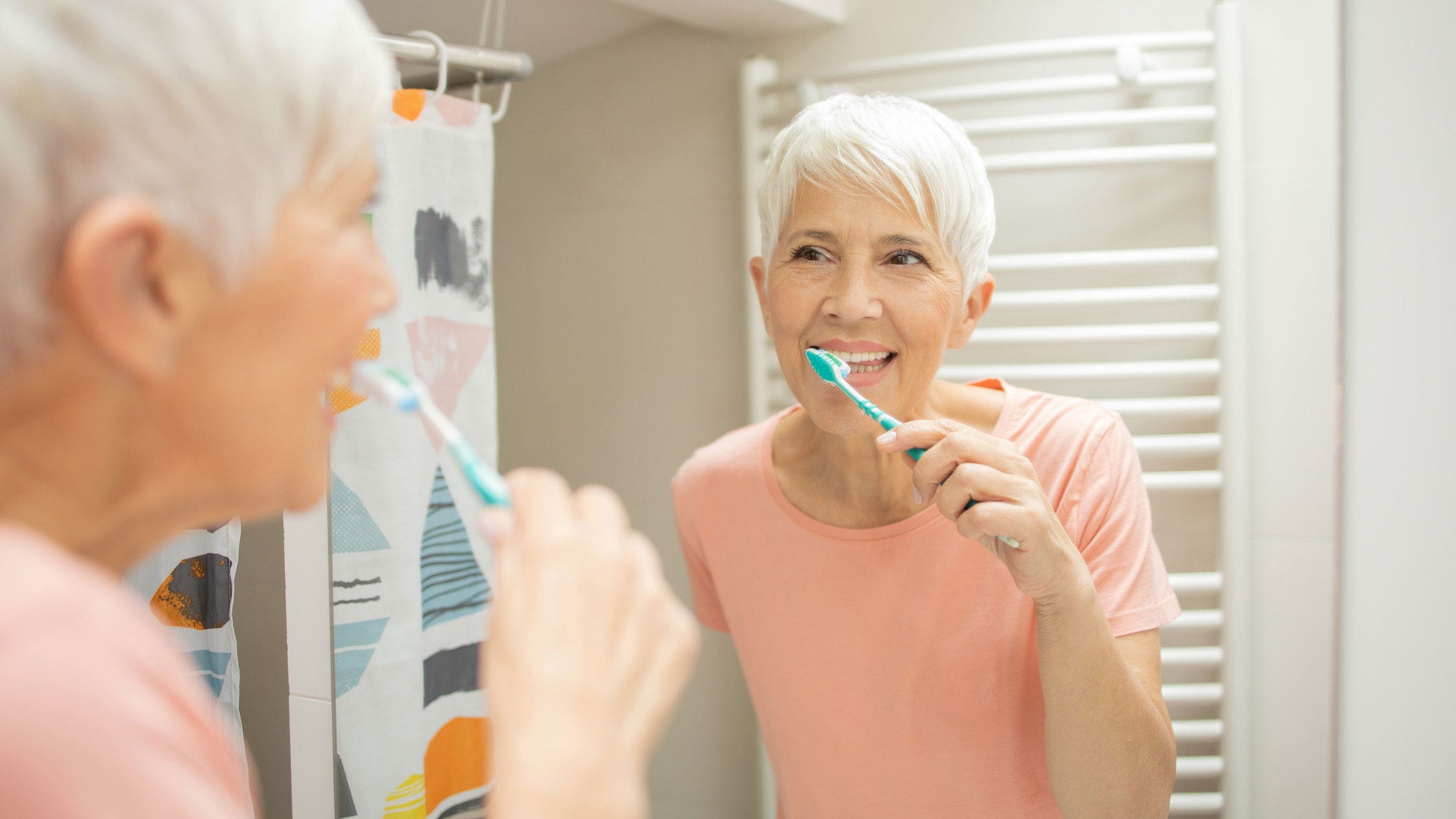Health
‘Reversing’ Alzheimer’s: Here are exercises to make the brain more resilient

Can Alzheimer’s disease be reversed?
Dr. Heather Sandison, a renowned expert in Alzheimer’s disease and related dementia care, believes that reversal isn’t just possible — but that it’s already happening in multiple patients.
In her new book “Reversing Alzheimer’s: The New Tool Kit to Improve Cognition and Protect Brain Health,” which was published by HarperCollins on June 11, Sandison — who is based in California — offers a step-by-step guide to helping Alzheimer’s patients improve their overall brain health.
NEW ALZHEIMER’S TREATMENT ACCELERATES REMOVAL OF PLAQUE FROM THE BRAIN IN CLINICAL TRIALS
One of the core elements of Sandison’s program is a focus on exercise as one of the most important lifestyle factors in preventing and controlling dementia.
Research has shown that physical activity can reduce the likelihood and progression of Alzheimer’s.
Dr. Heather Sandison, at left, is a naturopathic doctor specializing in neurocognitive medicine and the founder of Solcere Health Clinic, San Diego’s premier brain optimization clinic, and Marama, the first residential memory care facility to have the goal of returning cognitively declined residents to independent living. (Dr. Heather Sandison/iStock)
In the excerpt below, Sandison offers some specific recommendations for the types of exercise that can benefit patients living with the disease.
Read an excerpt from ‘Reversing Alzheimer’s’
Dr. Heather Sandison: Need a new motivation to be active? Exercise is medicine for the brain and provides an amazing array of benefits.
Most obviously, exercise increases blood flow throughout the body, including to the brain. That means getting your body moving will deliver more oxygen and nutrients to your brain while also flushing away more waste products.
Exercise also strengthens the heart and cardiovascular system, which helps improve blood flow even when you’re not working out; it also reduces the risk of arterial plaques that might disrupt blood flow to the brain and contribute to dementia.
ALL ABOUT ALZHEIMER’S DISEASE: SIGNS, SYMPTOMS AND STAGES
The overarching reason that exercise is such a powerful health protector is that it is what’s known as a hormetic, or a beneficial stressor.
Basically, when you put your body through its paces, the body is forced to use up resources, and your tissues can even be broken down a bit. (That’s what happens when you lift weights: Your muscles tear a tiny bit.)

Dr. Heather Sandison, an expert in Alzheimer’s disease and related dementia care, believes that reversal isn’t just possible but that it’s already happening in multiple patients. (Dr. Heather Sandison)
In that sense, you’re introducing stress to your system, but that stress is a force for good, because it triggers your body to get more efficient at using its resources and your tissues to grow back even stronger. In other words, exercise makes your body — including your brain — more resilient.
Exercise benefits several of the root causes of neurological disease.
It improves structure by increasing your cardiovascular capacity and boosting circulation, which delivers oxygen and nutrients to the brain.
FOR ALZHEIMER’S PATIENTS, EATING POMEGRANATES COULD HELP ALLEVIATE SYMPTOMS, STUDY SAYS: ‘PROMISING RESULTS’
It reduces stress in multiple ways — by giving you an outlet to blow off steam, by producing feel-good hormones such as endorphins and lowering the stress hormone cortisol, and, depending on what kind of exercise you choose, getting you outside and into nature, which is a well-known stress reliever.
It can also be social, and a great way to spend time with friends or even meet new people, which helps address the loneliness and social isolation that The Lancet lists as one of the modifiable risk factors for Alzheimer’s disease.

In her new book “Reversing Alzheimer’s: The New Tool Kit to Improve Cognition and Protect Brain Health,” published by HarperCollins on June 11, Sandison — based in California — offers a step-by-step guide to helping Alzheimer’s patients improve their overall brain health. (HarperCollins)
It improves sleep by tiring you out.
It strengthens immune function, which reduces the risk and effects of infection — all those muscular contractions and moving against gravity improves the flow of lymphatic fluid, which delivers immune cells and flushes away invader cells.
“Exercise benefits several of the root causes of neurological disease.”
It promotes detox, both through increased circulation and through sweating.
It improves signaling, as challenging and strengthening your muscles triggers the release of multiple signaling molecules, known as exerkines, that have demonstrated neuroprotective functions.

“The overarching reason that exercise is such a powerful health protector is that it is what’s known as a hormetic, or a beneficial stressor,” Sandison writes in her new book. (Dr. Heather Sandison)
If you do only one thing: Change up your current exercise routine in a way that challenges your brain and amps up the intensity.
If you are a devoted walker, find a new route that includes hills or stairs. If you’re open to trying something different, check out a new exercise class that you’ve been meaning to try.
Categories of exercise: some familiar, some cutting-edge
There are four types of exercise that you want to prioritize. Four may sound like a lot, but they are not mutually exclusive.
You can combine at least two types of exercise in one session — you can turn strength training into cardio by performing your strength moves in high-intensity intervals, or you can make your cardio dual task by doing something that requires your mental focus while you move.
Aerobic exercise
Aerobic exercise is what we think of as “cardio” — it gets your heart and blood pumping and includes forms of exercise such as walking, jogging, biking, dancing and swimming.
Aerobic exercise strengthens your heart, and what’s good for your heart is also good for your brain, because your heart sends the brain the blood, oxygen, and nutrients that your brain relies on to function.
EXPERIMENTAL ALZHEIMER’S DRUG GETS FDA ADVISORY PANEL’S THUMBS-UP: ‘PROGRESS IS HAPPENING’
Your first goal with adding more exercise to your life is to get 150 to 200 minutes of aerobic exercise each week so that you get your heart rate into the vigorous zone of 70-85% of maximum heart rate.
Listening to your body and adjusting your intensity level based on your perceived exertion is one of the best ways to know if you are pushing yourself hard enough.
Strength training
Strength training — also known as resistance training — is just what it sounds like: using weights or other forms of resistance to build muscle tissue.
Building muscle — particularly in the big muscle groups of the legs, hips, and torso — is directly related to brain health, because these muscles generate brain-derived neurotrophic factor (BDNF), a “fertilizer” for the brain, cueing it to create new neuronal connections and promoting neuroplasticity.

Alzheimer’s patients should aim for at least two strength-training sessions per week, notes the author of a new book. (iStock)
You want to aim for at least two strength-training sessions per week. Strength training doesn’t have to involve your standard barbells and bench pressing your body weight.
You can use resistance bands, light dumbbells, or even the weight of your own body in exercises like squats, lunges and planks.
Even climbing stairs or hills counts as strength training and cardio in one activity, because they get your heart rate up as they also keep the muscles of the legs and hips strong.
Dual-task training
This next-level form of exercise combines physical movement with a cognitive challenge. The simplest form of this is walking and talking.
What is a cognitive challenge will vary from person to person, but if you’re in prevention mode, listening to a foreign language lesson or a nonfiction book while you walk outside or ride the stationary bike, and then pausing the recording to recap what you’ve just learned every few minutes, is a good option.
CLICK HERE TO SIGN UP FOR OUR HEALTH NEWSLETTER
For some people, going to a Pilates or yoga class or other class where you really have to pay attention to the teacher’s cues constitutes dual-task training — but not if it’s something you’ve been doing for long enough that you can zone out.
“Exercise is such a powerful health intervention that if we could just bottle it, we could probably get rid of chronic disease.”
And if you have already started experiencing measurable cognitive decline, dual-task training may look like going on a walk while pointing out the names of the plants that you pass along the way, or having someone quiz you on the names of family members, or recalling family stories or important dates.
Wherever you are, you want to be working right on your edge — you can almost feel the wheels of your brain turning in order to stay focused.
Contrast oxygen therapy
This relatively unique form of training alternates the amount of oxygen in the air you breathe as you exercise — an approach that encourages the tiniest blood vessels (known as your microvasculature) throughout your body, including your brain, to open up, resulting in greatly enhanced blood flow.
It’s similar to going to altitude to train and build your aerobic capacity, and it is incredibly valuable for cognitive function.

“Exercise does take time and effort, but making this one activity a regular part of your life addresses so many causal factors of dementia that it can profoundly reduce your risk,” Sandison says in her book. (iStock)
This type of exercise does require specialized gear. You can buy the device, or go find a clinic near you where you can try it out. It does require you to wear a mask that is hooked up to a machine while you exercise, and when the oxygen saturation is low, it can be intense because you have to work harder to bring in enough air.
In other words, contrast oxygen therapy is not for everyone. But if you are willing and able, it can be dramatically helpful.
For more Health articles, visit www.foxnews/health
Honestly, exercise is such a powerful health intervention that if we could just bottle it, we could probably get rid of chronic disease.
Exercise does take time and effort, but making this one activity a regular part of your life addresses so many causal factors of dementia that it can profoundly reduce your risk.
Excerpted with permission from the new book, “Reversing Alzheimer’s: The New Tool Kit to Improve Cognition and Protect Brain Health” (HarperCollins) by Dr. Heather Sandison, copyright © 2024 by Dr. Heather Sandison. All rights reserved.

Health
Single dose of 'magic mushrooms' provides 5 years of depression relief, researchers find

NEWYou can now listen to Fox News articles!
Psilocybin, the main psychoactive ingredient in magic mushrooms, could alleviate depression for at least five years after just one dose, according to a new study.
The research, presented June 18 at the Psychedelic Science 2025 conference in Denver, followed up with patients who had been diagnosed with clinical depression — also known as major depressive disorder (MDD) — and had participated in a previous psilocybin treatment study in 2020.
“Most people who participated in our trial reported improvements in depression symptom intensity or in the ways in which they experienced depression in their life, lasting up to five years after the trial,” study co-author Alan Davis, director of the Center for Psychedelic Drug Research and Education at The Ohio State University, told Fox News Digital.
PSYCHEDELICS AS POTENTIAL MENTAL HEALTH TREATMENT ARE EXPLORED BY TRUMP ADMINISTRATION
Doug Drysdale, CEO of the Canadian pharmaceutical company Cybin in Toronto, Ontario, told Fox News Digital that the outcome speaks to the “exciting” potential of psilocybin and other psychedelic-based treatments in treating MDD and other mental health conditions.
“The results of the study are certainly very encouraging,” said Drysdale, who was not involved in the study.
A worker holds dried psychedelic mushrooms. The results of the new study are “certainly very encouraging,” said one pharmaceutical company executive. (James MacDonald/Bloomberg via Getty Images)
Earlier studies pointed toward the possibility of psilocybin as a potential antidepressant, prompting researchers to conduct the first-ever randomized clinical trial.
The initial 2020 trial, published in JAMA Psychiatry, included 24 patients with major depressive disorder. Half received psilocybin at the beginning of the trial, and the other half received the treatment eight weeks later.
Each patient also underwent 11 hours of psychotherapy.
WHAT IS KETAMINE THERAPY? MORMON REALITY STARS TOUT CONTROVERSIAL TREATMENT
One month after treatment, 17 patients reported experiencing symptom relief. Fourteen of those reported full remission from depression, according to the published study.
“The effectiveness of psilocybin therapy after a single or only a few administrations represents another substantial advantage over commonly used antidepressants that require daily administration,” the researchers wrote.

Patients appeared to respond much faster to psychedelics than to traditional antidepressants, the researchers stated. (James MacDonald/Bloomberg via Getty Images)
The new study aimed to explore the longer-term effects of this treatment on 21 of the original trial participants.
Sixty-seven percent reported being in remission from depression five years after treatment, and they also had less anxiety and easier daily functioning.
“The study doesn’t account for naturalistic changes that could have affected their depression in the five years since the main trial.”
For those whose depression came back, many still reported lasting benefits in their attitudes, perspectives and ability to pursue things that were meaningful to them, Davis told Fox News Digital.
“Certainly, more controlled and rigorous study is required, but at least anecdotally, these findings are very interesting, and I am cautiously optimistic about the potential for extended efficacy provided by these types of treatments,” Drysdale added.

Sixty-seven percent of participants reported being in remission from depression five years after treatment, and they also had less anxiety and easier daily functioning. (JASON CONNOLLY/AFP via Getty Images)
Other factors may have also played a role in the participants’ long-term mental health benefits, such as psychotherapy sessions or other antidepressants, experts agreed.
“The study doesn’t account for naturalistic changes that could have affected their depression in the five years since the main trial, and the sample is not representative of the population of people suffering with depression,” Davis told Fox News Digital.
PARKINSON’S PATIENTS WHO TAKE ‘MAGIC MUSHROOMS’ SEE KEY BENEFITS, STUDY FINDS
Psilocybin has also been explored as a potential treatment for post-partum depression (PPD), which affects as many as one in seven new mothers.
A 2022 study outlined the potential role of psychedelics in PPD cases, finding that psilocybin has been shown to catalyze a sense of “reconnection” in new mothers.
CLICK HERE TO SIGN UP FOR OUR HEALTH NEWSLETTER
“This effect in PPD, by fostering a sense of ‘reconnection’ for the mother, may allow for improved mood and maternal sensitivity toward the infant, which can positively impact maternal role gratification and the mother-infant relationship,” the researchers stated.
In February, Cleveland Clinic reported on an upcoming study that explores single-dosing psilocybin as a way to treat PPD.

Psilocybin has been explored as a potential treatment for post-partum depression (PPD), which affects as many as one in seven new mothers. (iStock)
The trial, now in its second phase, focuses on RE104, a proprietary drug similar to psilocybin.
Study participants will undergo multiple physical and mental health tests.
Potential risks and limitations
Ryan Moss, chief science officer at Filament Health, a clinical-stage natural psychedelic drug development company in Canada, has emphasized the importance of administering psychedelics in a safe setting when treating mental health conditions.
For more Health articles, visit www.foxnews.com/health
“Psychedelic experiences can sometimes feature anxiety, hallucinations and paranoia,” Moss previously told Fox News Digital.
Experts recommend that therapeutic use of psychedelics should be carefully managed by medical experts.
“Some patients using traditional psychedelics have reported experiencing adverse cardiovascular events during clinical trials.”
To mitigate these risks, Moss recommended clinical trial participants receive thorough preparation and monitoring by trained professionals during sessions.

Other factors may have also played a role in the participants’ long-term mental health benefits, noted an expert (not pictured), such as psychotherapy sessions or other antidepressants. (iStock)
Dr. Marc Siegel, clinical professor of medicine at NYU Langone Medical Center and Fox News’ senior medical analyst, previously interviewed two of the country’s top researchers on psychedelics: Dr. Rachel Yehuda, founder and director of the Center for Psychedelic Psychotherapy and Trauma Research at Mt. Sinai in New York, and Dr. Charles Marmar, director of the PTSD research program at NYU Langone.
“They agree there is therapeutic potential if very carefully studied under very strict medical guidance, but there is a huge downside in terms of unregulated recreational uses,” Siegel told Fox News Digital at the time.
“Both doctors see likely therapeutic value to psychedelics if carefully managed by medical experts,” Siegel added.
Melissa Rudy and Angelica Stabile, both of Fox News Digital, contributed reporting.
Health
Experimental drug helps patients lose nearly a quarter of body weight in early trials

NEWYou can now listen to Fox News articles!
An experimental weight-loss medication was shown to help people lose nearly 25% of their body weight in early-stage 1a/2b trials.
The drug, amycretin — developed by Novo Nordisk — works by replicating two hunger hormones — amylin, which regulates appetite and creates a feeling of fullness, and glucagon-like peptide 1 (GLP-1), the same hormone that is used in Ozempic and Wegovy to suppress appetite and boost insulin secretion.
“Amycretin is the first treatment to harness the two distinct biological pathways stimulated by amylin and GLP-1 in a single molecule,” Martin Holst Lange, executive vice president and head of development at Novo Nordisk, previously said in a statement sent to Fox News Digital.
GRANDFATHER’S SIMPLE CHANGES REVERSED PRE-DIABETES DIAGNOSIS THAT LEFT HIM ‘PETRIFIED’
In the study, which included 125 overweight or obese adults, participants who received weekly injections of amycretin lost more weight than those who took a placebo, according to a press release from Novo Nordisk.
Those who got the highest doses (up to 60 mg) lost up to 24.3% pounds after 36 weeks, compared to just 1.1% for the placebo group, per the release.
An experimental weight-loss medication was shown to help people lose nearly 25% of their body weight in early-stage 1a/2b trials. (iStock)
A previous phase 1 trial of the oral (pill) version of amycretin also showed that treatment was “safe and tolerable,” with an “observed reduction in body weight” compared to placebo, the company stated.
Taking the pill once a day led to around 10% weight loss, and those who doubled the dose lost 13%.
YOUR DNA COULD BE STOPPING YOU FROM LOSING WEIGHT, NEW STUDY SUGGESTS
Another benefit the researchers highlighted is that people taking amycretin did not appear to hit a “weight-loss plateau,” continuing to shed pounds as long as they took it.
“The lack of weight loss plateauing indicates the possibility of achieving further weight reductions with extended treatment,” Agnes Gasoirek, a senior clinical pharmacology specialist at Novo Nordisk, wrote in the phase 1 study findings.

Novo Nordisk presented the latest findings at the American Diabetes Association in Chicago on June 22. ((Photo by LISELOTTE SABROE/Scanpix Denmark/AFP via Getty Images))
Novo Nordisk presented the latest findings at the American Diabetes Association in Chicago on June 22; they were also published in the medical journal Lancet.
“We are pleased with the promising results of amycretin and the feedback from regulatory authorities and are excited to advance both subcutaneous and oral versions of this molecule into phase 3 development for weight management,” said Martin Holst Lange, executive vice president for Development at Novo Nordisk, in the release.
“Amycretin is the first treatment to harness the two distinct biological pathways stimulated by amylin and GLP-1 in a single molecule.”
“These results reflect our robust pipeline in obesity, [and] our focus on progressing scientific innovation and expanding the range of options available to patients and healthcare professionals.”
The most common side effects of amycretin, similar to other GLP-1s, were gastrointestinal symptoms — primarily nausea, vomiting and decreased appetite.
Adverse events were “mild to moderate” in severity, according to researchers. More frequent doses resulted in greater side effects.
It’s important to monitor these side effects closely, experts advise, as GI issues are common among patients with obesity.

“Obesity is a chronic, multifactorial disease that requires a comprehensive, long-term approach,” a doctor said. (iStock)
“While the initial weight-loss outcomes are indeed encouraging, further studies are needed to ensure that the therapeutic benefits consistently outweigh the potential risks, especially with long-term administration,” Dr. Christine Ren-Fielding, director and chief of bariatric surgery at the NYU Langone Weight Management Program, previously told Fox News Digital.
CLICK HERE TO SIGN UP FOR OUR HEALTH NEWSLETTER
While GLP-1-based drugs — including this new experimental pill — may show promising results, Ren-Fielding, who was not involved in the study, emphasized that they’re “not a cure-all for obesity.”
“Obesity is a chronic, multifactorial disease that requires a comprehensive, long-term approach,” she said at the time.
For more Health articles, visit www.foxnews.com/health
“Pharmacological treatments can play a significant role in managing the condition, but they are often most effective when combined with other interventions.”
Next, Novo Nordisk plans to prepare for phase 3 trials of the medication, in both oral and injectable forms, for the management of obesity.
Health
Dental experts reveal 6 essential tips to prevent tooth loss in aging adults

Dentist shares symptoms of ‘chemo mouth’
Dr. Rajiv Saini, a dentist and periodontal specialist from Katy, Texas, discusses one of those lesser-known side effects of chemotherapy and radiation for cancer patients.
NEWYou can now listen to Fox News articles!
Some may assume that losing teeth is just part of growing older.
Around 11% of adults between the ages of 65 and 74 have lost all of their teeth, according to 2020 data from the U.S. Centers for Disease Control and Prevention (CDC) — and that number rises to one in five at age 75 and older.
But according to experts, this isn’t inevitable. Dental professionals shared the following tips to prevent tooth loss and boost overall health.
1. Protect gum health
About two in three adults over age 65 are dealing with some form of gum disease, according to a recently published AARP report.
6 SIMPLE WAYS TO PROTECT YOUR HEARING NOW BEFORE IT’S TOO LATE, ACCORDING TO EXPERTS
Clinical experts cited in the report, including Dr. Uchenna Akosa, assistant professor and director at Rutgers Health University Dental Associates in New Jersey, warn that bleeding gums can signal a much deeper problem.
“Even if you have not lost any teeth, gum disease impairs your ability to chew hard food,” Akosa told AARP. “That will affect your nutrition and can put you at risk of malnutrition in the future.”
If your gums bleed when brushing, or if you notice sensitivity or recession, those are signs to schedule a dental visit. (iStock)
Left untreated, gum disease can also destroy the bones that hold teeth in place and may interfere with nutrition and chewing.
Gum disease is also a source of chronic inflammation in the body, which can contribute to dementia risk, studies have shown. A meta-analysis of about 34,000 people found that older adults who had lost all of their teeth had a 1.4 times greater risk of developing dementia, as cited by AARP.
The publication also points to previous research linking gum disease to other health risks, such as heart attack, stroke and cancer.
Around 11% of adults between the ages of 65 and 74 have lost all of their teeth.
Experts recommend focusing on early prevention. If your gums bleed when brushing, or if you notice sensitivity or recession, those are signs to schedule a dental visit.
Regular professional cleanings and checkups can catch gum problems before they lead to tooth loss or other health effects.

People who had lost all of their teeth had a 1.4 times greater risk of developing dementia, according to the AARP. (iStock)
AARP reports that switching to an electric toothbrush, brushing twice daily for two minutes and using a water flosser are all effective ways to protect gum health.
Dr. David Frey, a cosmetic dentist at Your Perfect Smile in Beverly Hills, California, said that he often recommends water flossers – particularly the Sonic-Fusion by Waterpik – to older patients.
“It’s especially valuable for patients with arthritis, limited mobility or trouble using traditional floss,” Frey told Fox News Digital.
2. Take steps to prevent dry mouth
Saliva plays an essential role in neutralizing acids and protecting tooth enamel, but dry mouth affects nearly six in 10 older adults, according to AARP.
Many common medications — including antihistamines, antidepressants and blood pressure drugs — can reduce saliva production, making the mouth more prone to tooth decay, infection and gum disease, WebMD states.
IS OZEMPIC RUINING YOUR TEETH? WHAT TO KNOW ABOUT IMPACT ON DENTAL HEALTH
To prevent dry mouth, AARP recommends sipping water regularly, rinsing the mouth after eating, asking your dentist about prescription-strength fluoride toothpaste, and using dry mouth rinses like Biotene or Act.
3. Personalize your dental visits
Contrary to the standard six-month checkup rule, AARP notes that dental care schedules should be personalized.
One doctor in the report noted that there’s “nothing magical about a six-month checkup” — some people may only need to go once a year, while others, especially those with chronic conditions, may need more frequent visits.

The recommended frequency of dental visits is not one-size-fits-all, according to AARP. Some people may only need to go once a year, while others, especially those with chronic conditions, may need more frequent visits. (iStock)
Oral health issues in older adults often go unnoticed, especially those related to bite alignment, according to Frey.
“Bite-related issues are often an overlooked source of headaches and neck pain,” he told Fox News Digital. “The public simply hasn’t been informed that tension, misalignment and jaw dysfunction can manifest in ways that seem unrelated at first glance.”
Evaluating bite position and jaw health can sometimes reveal the root causes of chronic discomfort, Frey noted.
“When I combine 3D imaging with a close exam of the teeth — worn surfaces, tiny fractures and chipping — it often reveals that the muscles around the head and neck aren’t in harmony with the bite.”
4. Explore options for financial help
Only three in 10 adults over 65 have dental insurance, per the American Dental Association, and Medicare typically doesn’t cover cleanings, fillings or other routine procedures.

Many common medications can reduce saliva production, making the mouth more prone to decay, experts say. (iStock)
This financial gap often leads people to skip dental care altogether, which can cause more serious (and expensive) problems in the future.
AARP suggests looking into dental savings plans, local dental schools or sliding-scale community clinics if coverage is an issue.
5. Adopt healthy habits
Smoking is a major contributor to tooth loss.
CDC data shows that smokers are up to three times more likely to lose all their teeth than non-smokers.

CDC data shows that smokers are up to three times more likely to lose all of their teeth than non-smokers. (iStock)
And while sugary cough drops or hard candies may seem harmless, they can be damaging to tooth enamel over time, experts warn.
Switching to sugar-free gum or candies containing xylitol may help prevent cavities and support better oral health, Akosa told AARP.
6. Restore appearance
One of the biggest misconceptions about aging and dental health is that worn, discolored teeth are something to simply accept, according to Frey.
“It’s not just about revitalizing the teeth — it’s about revitalizing the person.”
“A delicate, thin porcelain veneer can restore the vitality, color and shape your teeth once had, enhancing your smile and overall appearance,” he told Fox News Digital.
“And it’s not just cosmetic — it’s about restoring health, confidence and proper function.”

AARP reports that switching to an electric toothbrush, brushing twice daily for two minutes and using a water flosser are all effective ways to protect gum health. (iStock)
According to Dr. Frey, “It’s not just about revitalizing the teeth — it’s about revitalizing the person.”
CLICK HERE TO SIGN UP FOR OUR HEALTH NEWSLETTER
For those looking to brighten their smile, Erin Fraundorf, founder of BOCA Orthodontic and Whitening Studio in St. Louis, recommends seeing a dentist before trying any whitening treatments, per the AARP report.
For more Health articles, visit www.foxnews.com/health
“In-office treatments remain the safest, most effective option, while professional-grade take-home kits and OTC products can be great for maintenance,” Fraundorf said.
-

 Arizona6 days ago
Arizona6 days agoSuspect in Arizona Rangers' death killed by Missouri troopers
-

 News1 week ago
News1 week agoAt Least 4 Dead and 4 Missing in West Virginia Flash Flooding
-

 News1 week ago
News1 week agoOakland County sheriff urging vigilance after shootings of 2 Minnesota lawmakers
-

 Culture1 week ago
Culture1 week agoBook Review: “The Möbius Book, by Catherine Lacey
-

 Technology1 week ago
Technology1 week agoTanks, guns and face-painting
-

 News1 week ago
News1 week agoVideo: Trump's Military Parade Met With Nationwide Protests
-

 World1 week ago
World1 week agoAt least 100 people killed in gunmen attack in Nigeria: Rights group
-

 Business5 days ago
Business5 days agoDriverless disruption: Tech titans gird for robotaxi wars with new factory and territories














